You’ve probably walked past night-blooming flowers without knowing their secret lives after dark. These botanical performers wait until sunset to unfurl their petals, revealing spectacular blooms that last just 6-8 hours. While most flowers close up shop at dusk, these nocturnal treasures are just getting started, attracting specialized pollinators with powerful fragrances and luminous white petals that glow in the moonlight.
Contents
1. Queen of the Night

The Queen of the Night (Epiphyllum oxypetalum) is a striking epiphytic cactus known for its spectacular nocturnal blooming. This tropical plant produces large, fragrant white flowers that can reach up to 8 inches in diameter, opening for a single night before wilting by dawn. The dramatic blooms emerge from long, flat, leaf-like stems and release a sweet vanilla-like fragrance that attracts night-pollinating moths. Despite its brief flowering period, the plant has earned its regal name through the sheer magnificence of its ephemeral display.
- Light: Bright, indirect sunlight; protect from intense afternoon sun; can tolerate partial shade
- Water: Moderate watering during growing season; reduce in winter; allow soil to dry between waterings
- Soil: Well-draining, rich potting mix with added organic matter
- Temperature: 60-80°F (15-27°C); protect from frost
- Humidity: Moderate to high humidity (50-70%)
- Container: Hanging baskets or pots with good drainage
- Support: May need climbing support or trellis as stems grow
2. Egyptian Water Lily
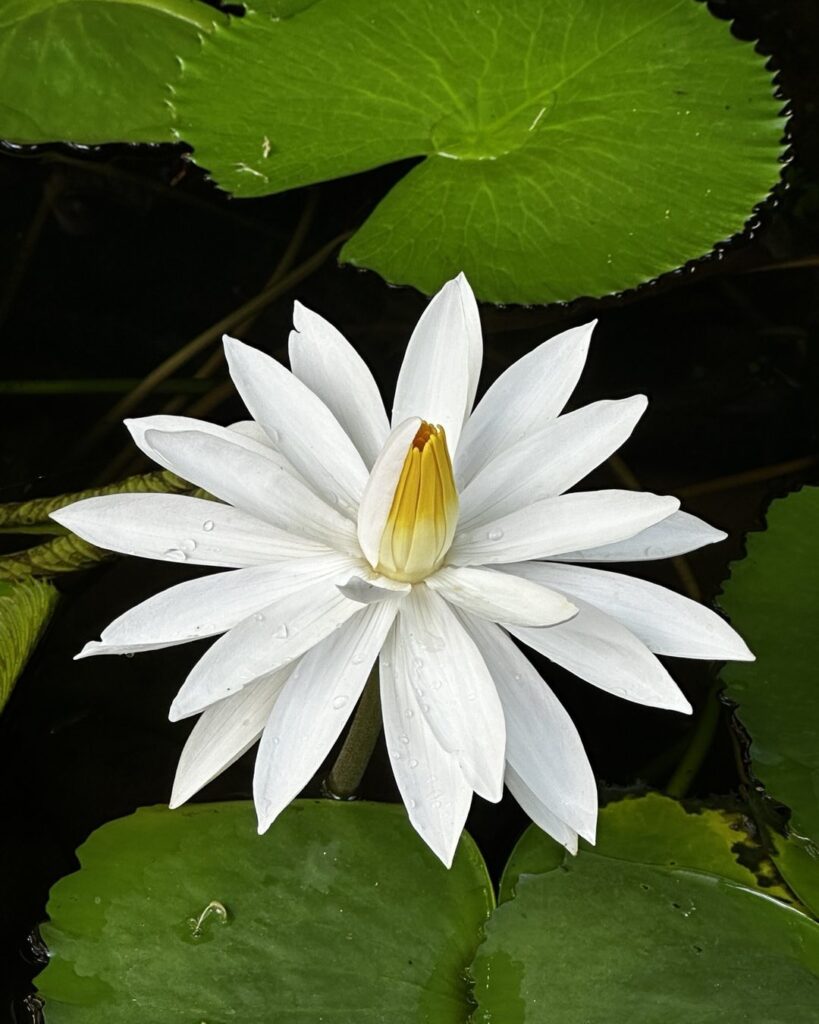
The Egyptian water lily (Nymphaea lotus) is a stunning aquatic plant that opens its fragrant white flowers only after sunset, typically between 8 PM and midnight. The blooms, which can reach up to 10 inches in diameter, remain open throughout the night and close by mid-morning the following day. This nocturnal flowering pattern helps the plant attract night-pollinating insects, particularly moths. The large, circular leaves float on the water’s surface during the day, providing shelter for aquatic life, while the flowers rise several inches above the water on sturdy stems.
- Light Requirements: Full sun to partial shade during the day; blooms in darkness
- Water Depth: 12-30 inches of water above the crown
- Water Temperature: 70-85°F (21-29°C)
- pH Level: 6.0-7.5
- Soil Requirements: Heavy clay loam or topsoil rich in organic matter
- Growing Zone: USDA zones 9-11
- Container Size: Minimum 24-inch wide pot or basket
- Fertilizer: Monthly applications of aquatic plant fertilizer tablets during growing season
3. Night-Blooming Jasmine
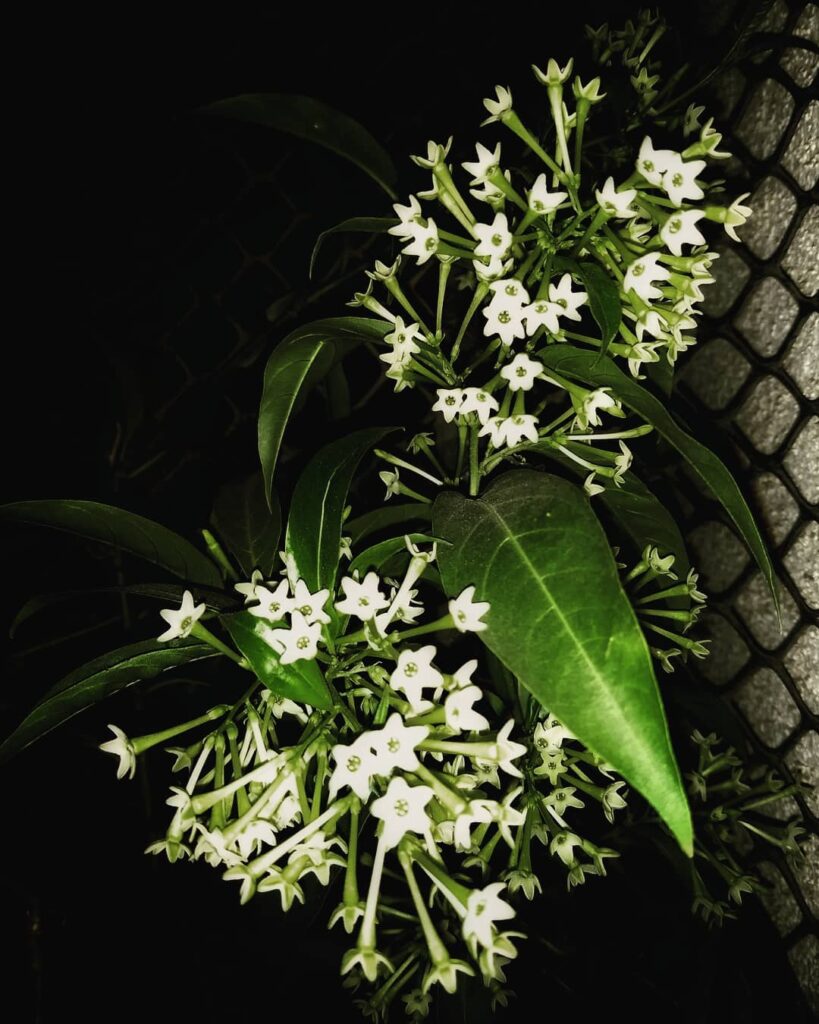
Night-blooming jasmine (Cestrum nocturnum) is a tropical evergreen shrub renowned for its intensely fragrant white-green tubular flowers that open at dusk and release their sweet perfume throughout the night. Though not a true jasmine, this plant can grow up to 8-13 feet tall and features glossy dark green leaves. The flowers appear in clusters during warm months, typically closing by morning, making it a popular choice for moon gardens and evening outdoor spaces where its enchanting scent can be fully appreciated.
- Light: Partial to full sun; tolerates afternoon shade in hot climates
- Water: Regular watering with moderate moisture; soil should dry slightly between waterings
- Soil: Well-draining, rich, slightly acidic soil with pH 6.1-7.5
- Temperature: Thrives in warm climates; cannot tolerate frost; ideal range 60-75°F (15-24°C)
- Humidity: Prefers moderate to high humidity
- Fertilizer: Monthly feeding during growing season with balanced fertilizer
- Zone: USDA zones 8-11
- Spacing: Plant 3-4 feet apart to allow for spread
4. Moonflower
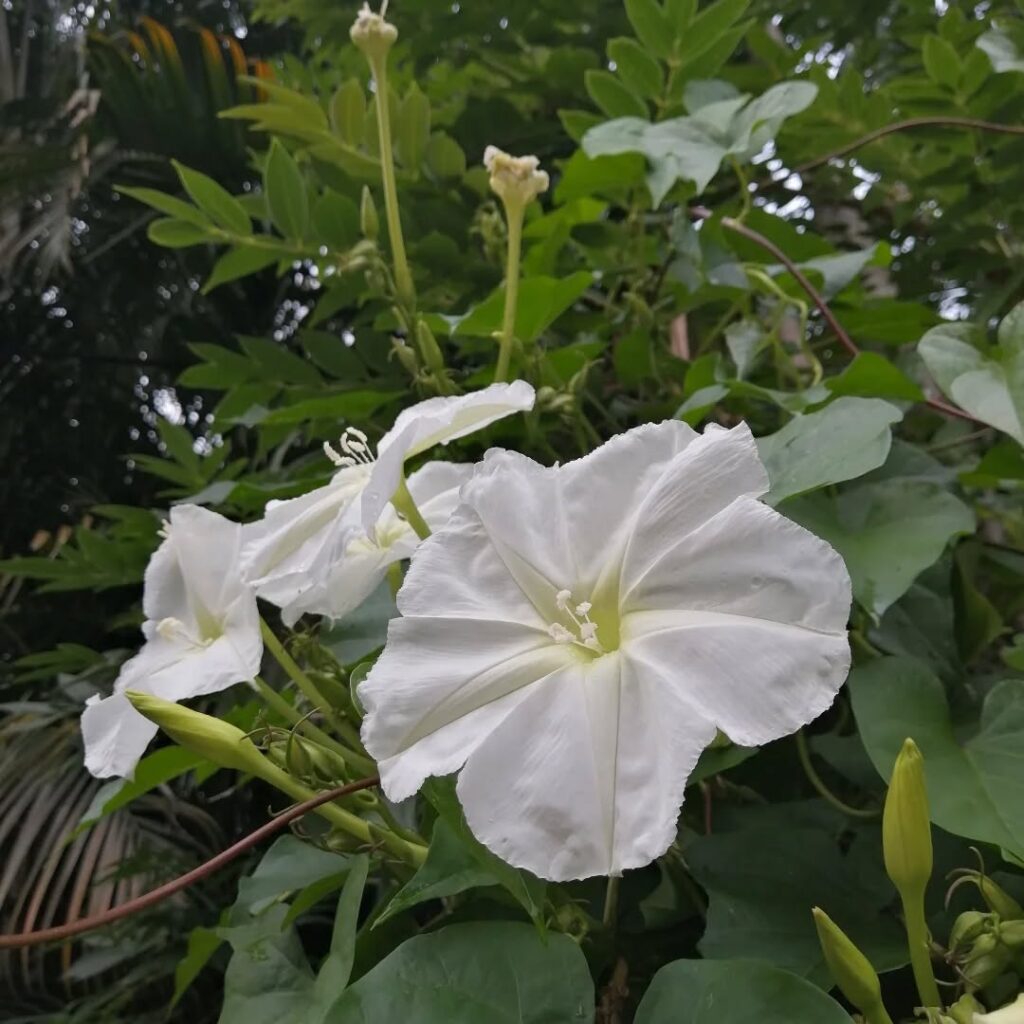
The Moonflower (Ipomoea alba) is a striking nocturnal vine that unfurls its large, white, fragrant blooms as the sun sets. Each flower opens within minutes, creating a mesmerizing display as the pure white petals expand to reveal a trumpet-shaped bloom that can reach up to 6 inches in diameter. These flowers remain open throughout the night, attracting night-flying moths and other nocturnal pollinators with their sweet fragrance, before closing permanently at dawn.
- Light: Full sun during day for vine growth; blooms in darkness
- Water: Regular watering to maintain consistently moist soil; avoid waterlogging
- Soil: Well-draining, rich organic soil with pH 6.0-7.0
- Temperature: 65-85°F (18-29°C)
- Spacing: 6-12 inches between plants
- Support: Requires trellis or fence for climbing
- Fertilizer: Monthly feeding with balanced fertilizer during growing season
5. Arizona Queen of the Night
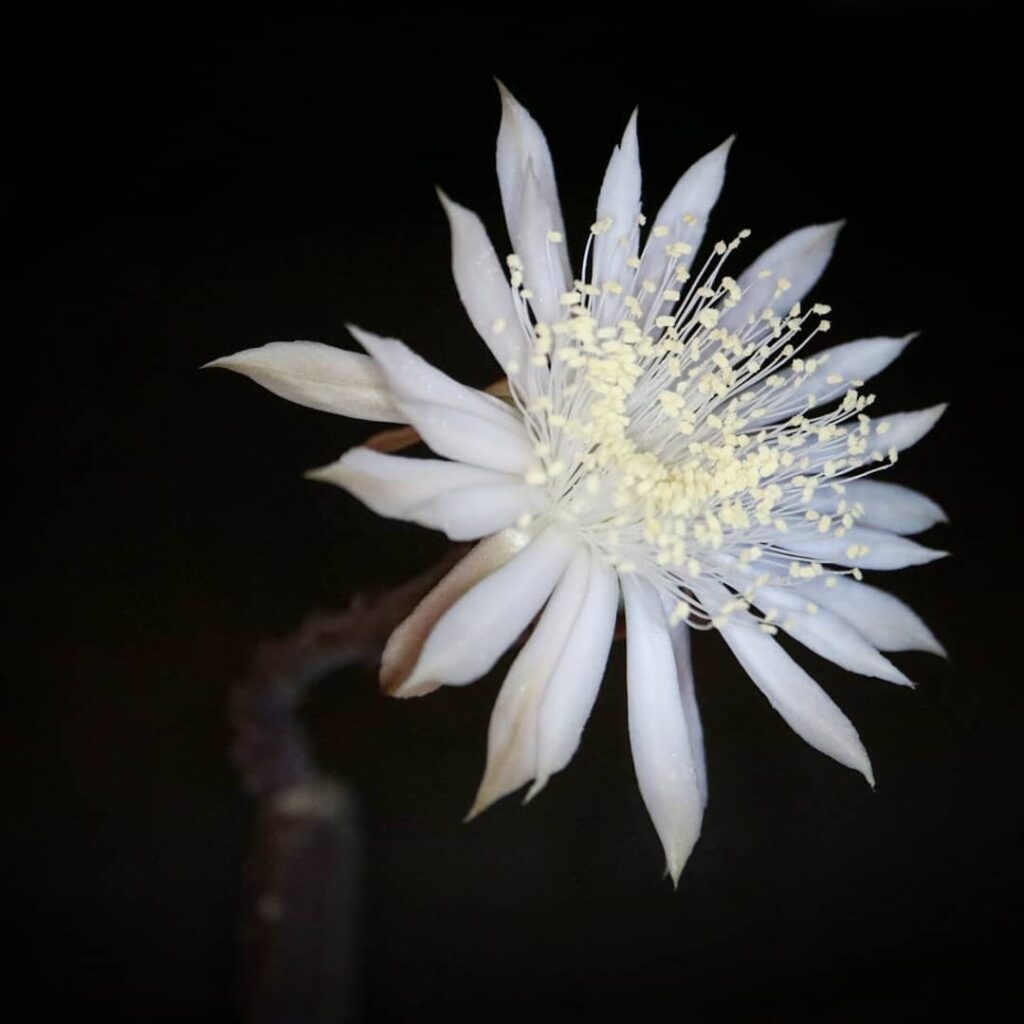
The Arizona Queen of the Night (Peniocereus greggii) is a rare and elusive cactus that produces breathtaking, fragrant white blooms for just a single night each year. Hidden among desert shrubs, its slender, vine-like stems remain inconspicuous until the moment of flowering. As dusk falls, the large, trumpet-shaped blossoms unfurl, releasing a sweet scent that attracts nocturnal pollinators like moths. By dawn, the flowers wilt, leaving behind a fleeting but unforgettable spectacle.
- Light: Full sun during the day; blooms in darkness
- Water: Infrequent watering; allow soil to dry completely between waterings
- Soil: Well-draining, sandy soil mimicking desert conditions
- Temperature: 85-100°F (29-38°C) during active growth
- Spacing: Typically grown individually due to its sprawling nature
- Support: Often relies on nearby shrubs for structural support
- Fertilizer: Minimal feeding; occasional low-nitrogen fertilizer during growing season
6. Night Phlox
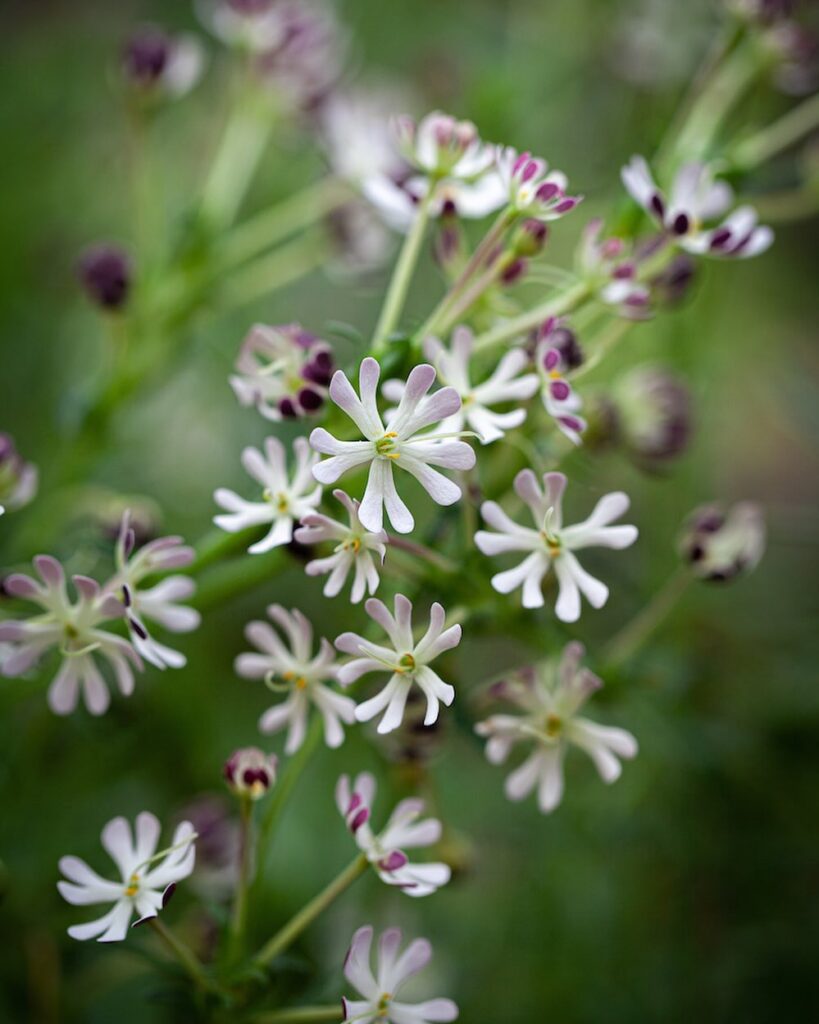
Night phlox (Zaluzianskya capensis) emits a powerful vanilla-honey fragrance that intensifies after sunset, making it a prized addition to moon gardens. This delicate annual flower keeps its small, pinwheel-shaped white or pink blooms tightly closed during daylight hours, only unfurling them in the evening to release their sweet scent that attracts nocturnal pollinators like moths.
- Light: Partial shade to full sun; afternoon shade preferred in hot climates
- Water: Regular watering to maintain consistently moist soil; avoid waterlogging
- Soil: Well-draining, fertile soil with pH 6.0-7.0
- Temperature: Thrives in mild climates; ideal growing range 60-75°F
- Spacing: Plant 6-8 inches apart
- Height: Grows 12-18 inches tall
- Season: Blooms summer through fall
- Fertilizer: Monthly feeding with balanced, water-soluble fertilizer
7. Corpse Flower
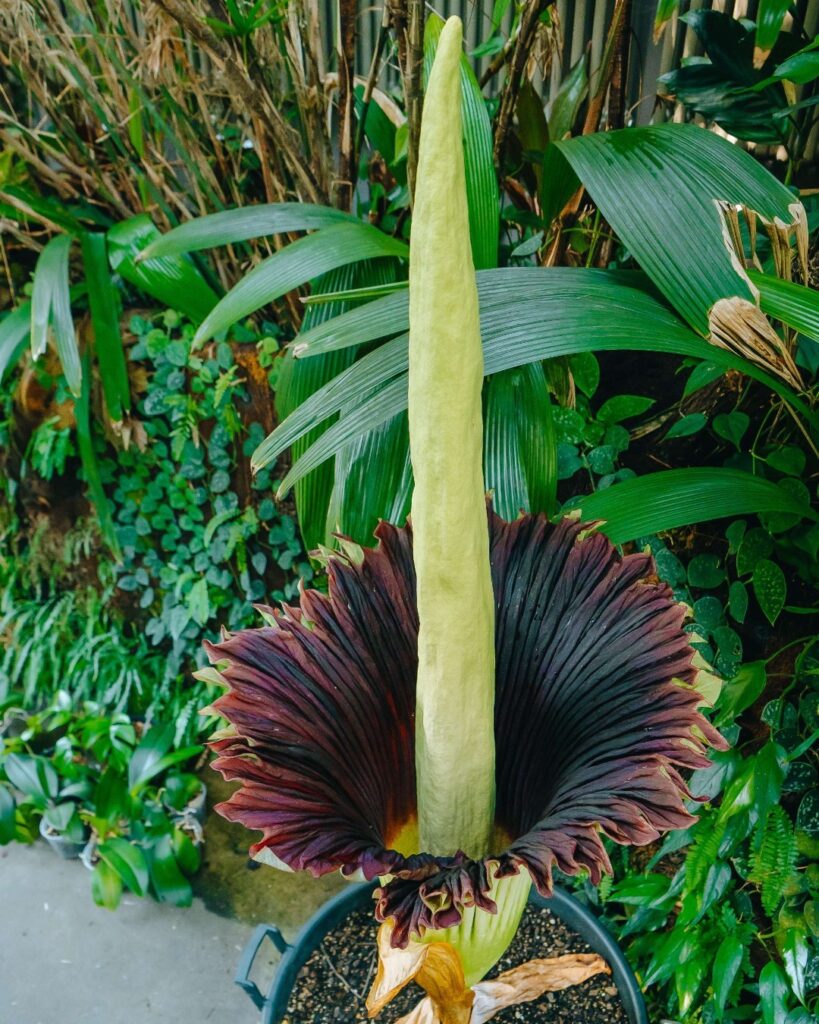
The corpse flower (Amorphophallus titanum) emits an intense rotting meat odor during its brief blooming period, which typically lasts only 24-48 hours. This powerful stench, often compared to decaying flesh, attracts pollinators like carrion beetles and flesh flies that typically feed on dead animals. The flower’s putrid smell is strongest at night when these insects are most active, and the odor can travel several feet away from the plant, helping to guarantee successful pollination in its native habitat.
- Light: Bright, indirect sunlight; partial shade in hot climates
- Water: Regular watering with well-draining soil; reduce watering during dormancy
- Soil: Rich, loose, organic potting mix with high humidity
- Temperature: Warm tropical conditions, 70-85°F (21-29°C)
- Humidity: High humidity levels, 75-90%
- Fertilizer: Monthly feeding during growing season with balanced fertilizer
- Space: Large containers or garden beds to accommodate massive size
- Drainage: Excellent drainage to prevent root rot
8. Flowering Tobacco Plant
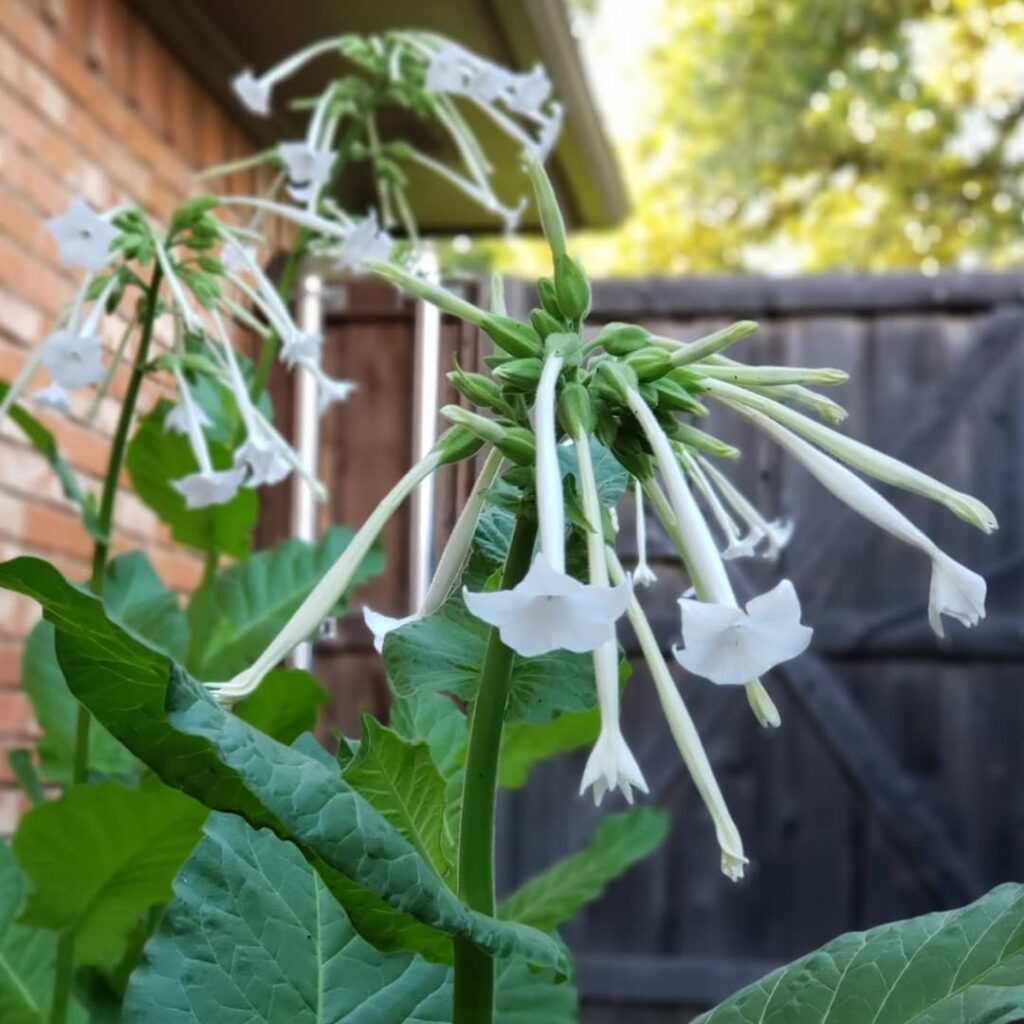
The night-blooming tobacco plant (Nicotiana sylvestris) is a tall, dramatic flowering plant that releases its sweet fragrance after sunset. Growing up to 5 feet tall, this plant produces clusters of elegant, tubular white flowers that hang downward like trumpets. The blossoms open in the evening and remain open throughout the night, attracting nocturnal pollinators such as moths with their intense jasmine-like perfume. By morning, the flowers typically close, only to reopen again at dusk.
- Light: Partial to full sun; tolerates afternoon shade
- Water: Regular watering to maintain consistently moist soil; reduce in winter
- Soil: Well-draining, rich organic soil with pH 6.1-7.8
- Temperature: Prefers 60-75°F (15-24°C)
- Spacing: 2-3 feet between plants
- Fertilizer: Monthly feeding with balanced fertilizer during growing season
- Hardiness: USDA zones 10-11; grown as annual in colder regions
9. Four O’clock Flower

The Four O’clock flower (Mirabilis jalapa) produces striking purple blooms that open in the late afternoon, typically around 4 PM, and remain open through the night until morning. These trumpet-shaped flowers emit a sweet fragrance and can reach 2-3 inches in length, creating a dramatic display against the plant’s dark green foliage. While purple is one of the most common colors, individual plants may produce flowers in varying shades of purple or even display multiple colors on the same plant.
- Light: Partial shade to full sun; afternoon shade preferred in hot climates
- Water: Regular watering to maintain moist soil; drought tolerant once established
- Soil: Well-draining, fertile soil with pH between 6.0-7.0
- Temperature: Thrives in warm weather; hardy in zones 7-10
- Spacing: Plant 12-24 inches apart
- Depth: Sow seeds 1/4 inch deep or plant tubers 2-3 inches deep
- Fertilizer: Monthly application of balanced fertilizer during growing season
10. Datura
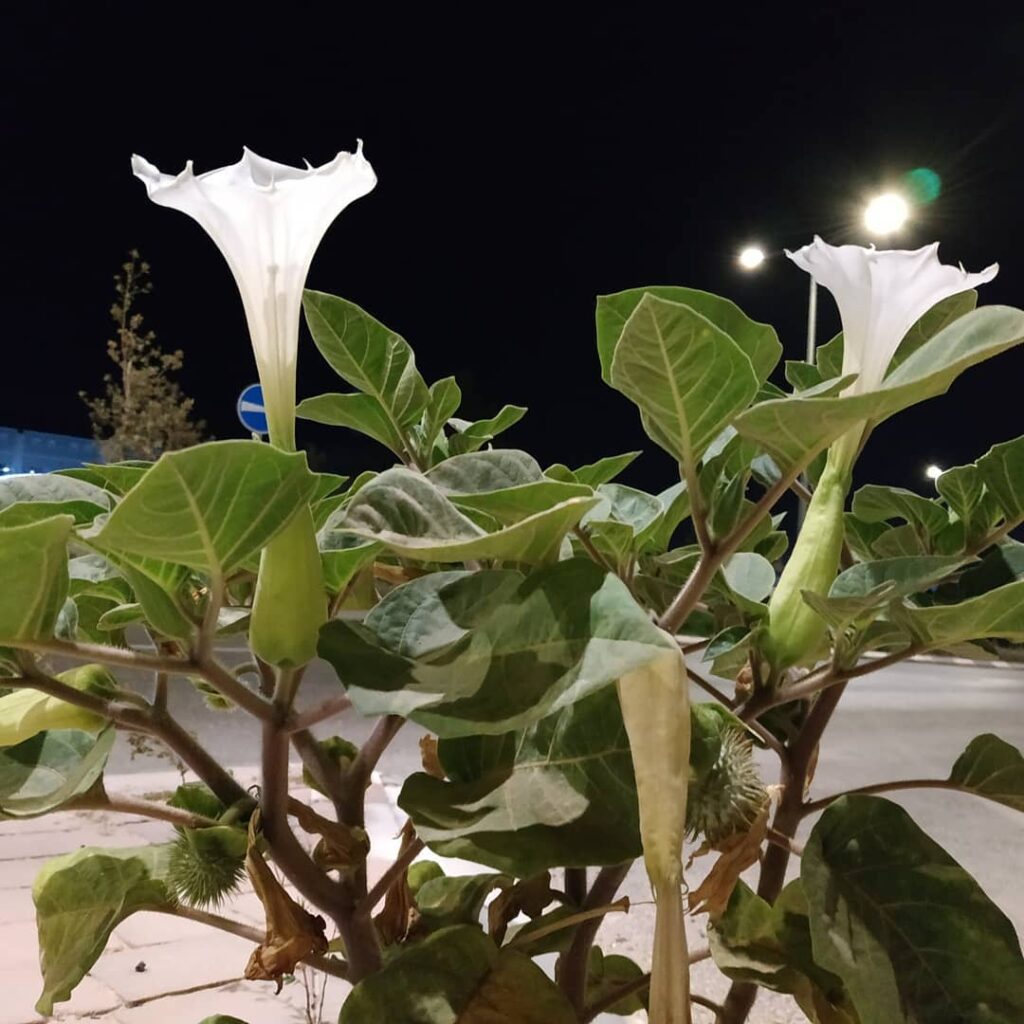
The Datura plant produces large, trumpet-shaped white flowers that unfurl dramatically at dusk and remain open through the night until the following morning. These pristine white blooms can reach up to 6-8 inches in length and emit a sweet, intoxicating fragrance that attracts nocturnal pollinators like moths. The flowers emerge from long, tubular buds that twist and unfold in a mesmerizing spiral pattern as they open, creating a striking display against the plant’s dark green foliage.
- Light: Full sun to partial shade; tolerates afternoon shade in hot climates
- Water: Moderate watering; drought-tolerant once established; avoid overwatering
- Soil: Well-draining, sandy or loamy soil with pH 6.0-7.0
- Temperature: Thrives in warm conditions, 65-80°F (18-27°C)
- Spacing: 3-4 feet between plants to allow for spread
- Fertilizer: Light feeding with balanced fertilizer during growing season
- Hardiness: USDA zones 7-10, grown as annual in colder regions
11. Marsh Afrikaner
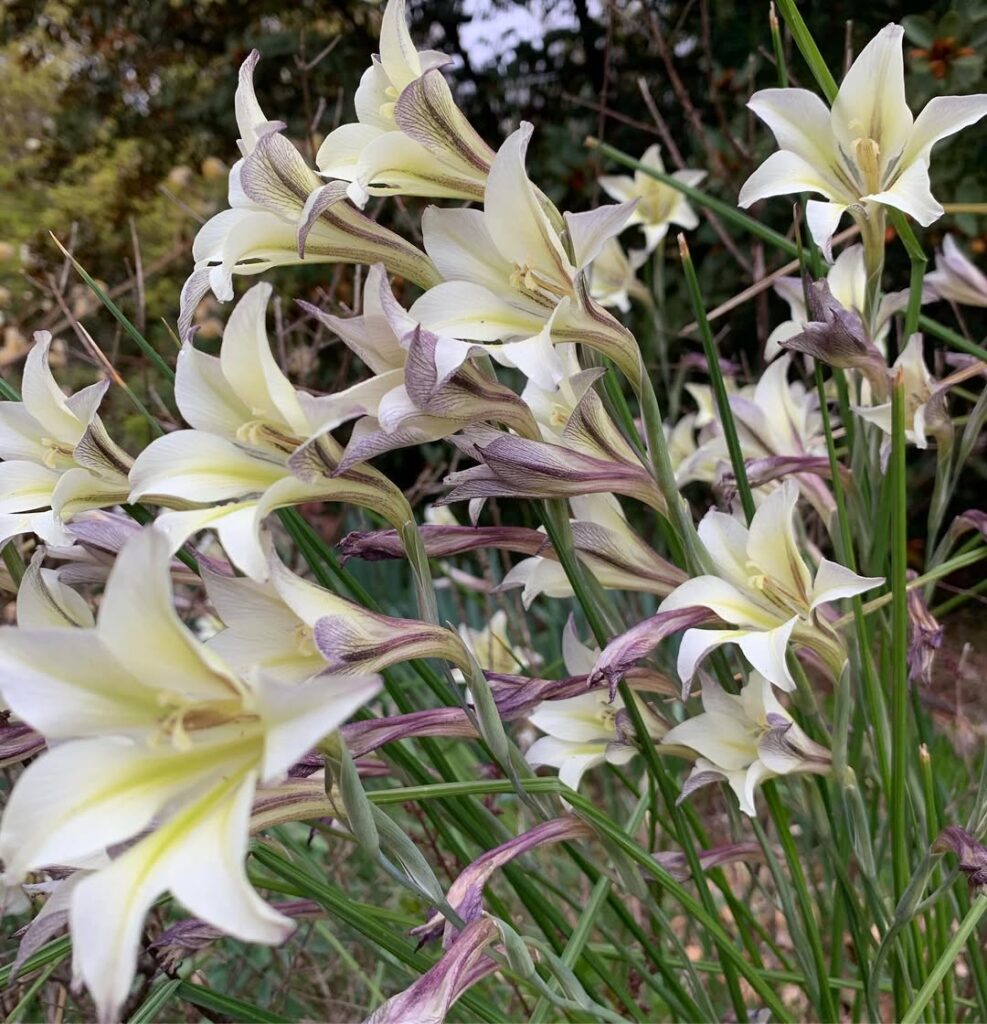
Marsh Afrikaner (Gladiolus tristis) is a unique variety of gladiolus that releases its sweet fragrance and opens its elegant pale flowers after sunset. Unlike its daytime-blooming relatives, this South African native produces creamy white to pale yellow blooms that remain closed during daylight hours and unfurl in the evening, attracting night-pollinating moths with their intense almond-like scent. The flowers grow on tall stems reaching 2-3 feet in height, with narrow, sword-like foliage typical of gladiolus species.
- Light: Full sun to partial shade during the day, though flowers open at night
- Water: Regular watering during growing season, reduce during dormancy
- Soil: Well-draining, fertile soil with pH 6.0-7.0
- Temperature: Hardy in zones 7-10; prefers mild climates
- Planting depth: Corms should be planted 4-6 inches deep
- Spacing: 6-8 inches apart
- Growing season: Spring to early summer blooming
- Winter care: In colder regions, lift corms after foliage dies back and store in cool, dry place
12. Night-Blooming Orchid
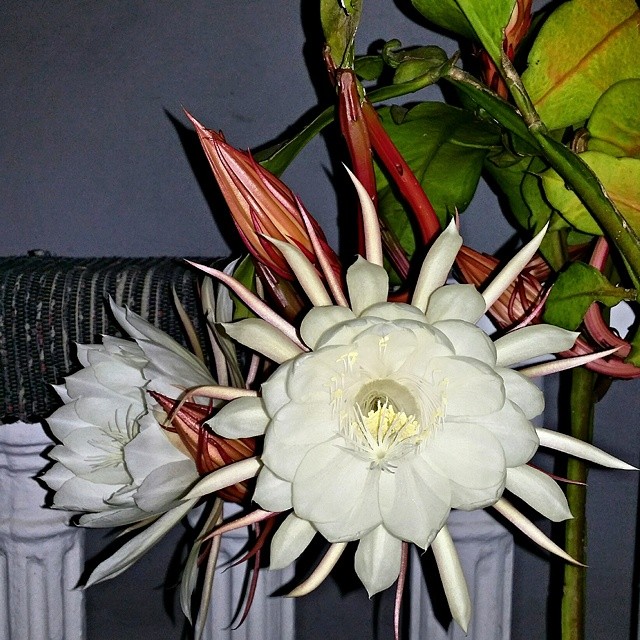
The night-blooming orchid (Bulbophyllum nocturnum) is the first-known orchid species that consistently flowers at night. This rare orchid, discovered in Papua New Guinea, produces small blooms that open around 10 PM and close before dawn. The flowers are approximately 2-3 centimeters wide, featuring delicate greenish-yellow petals with reddish spots. Each bloom lasts only a single night, and the plant typically flowers several times throughout the year. Scientists believe this unusual nocturnal flowering pattern evolved to attract specific nighttime pollinators.
- Light: Bright, indirect light during the day; tolerates low light conditions
- Temperature: Warm environment, 65-85°F (18-29°C)
- Humidity: High humidity levels, 60-80%
- Water: Regular watering during growing season; reduce in winter
- Soil: Well-draining orchid mix with bark, charcoal, and sphagnum moss
- Container: Small pot with adequate drainage
- Fertilizer: Balanced orchid fertilizer applied monthly during growing season
